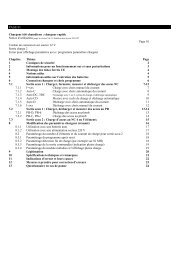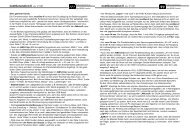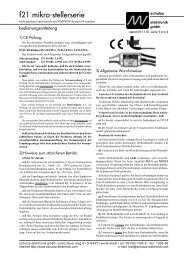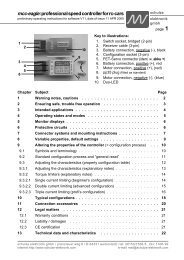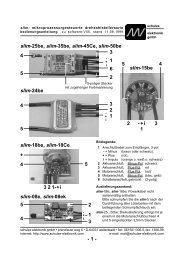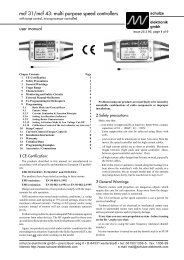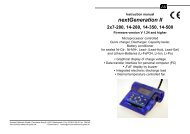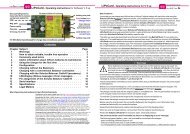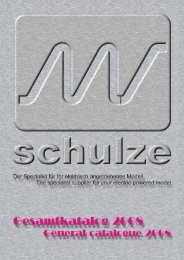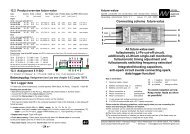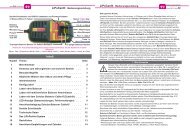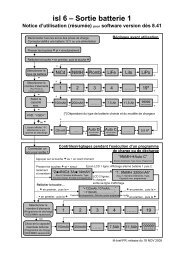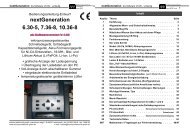ecolader: rapid discharger/charger series - Schulze Elektronik GmbH
ecolader: rapid discharger/charger series - Schulze Elektronik GmbH
ecolader: rapid discharger/charger series - Schulze Elektronik GmbH
You also want an ePaper? Increase the reach of your titles
YUMPU automatically turns print PDFs into web optimized ePapers that Google loves.
Page 4 <strong>ecolader</strong>: <strong>rapid</strong> <strong>dis<strong>charger</strong></strong>/<strong>charger</strong> <strong>series</strong><br />
3 Fitting the CE tube<br />
Requirements:<br />
- The conductor cross-section of the charge cables<br />
should be 2.5 mm2 .<br />
- One insulator should be coloured red (positive<br />
terminal +) and the other black (negative terminal<br />
-).<br />
- The charge cable should be no longer than 20<br />
cm (including the length of cable attached to<br />
the battery!) in order to meet CE requirements.<br />
1. Solder a banana plug to each cable. You can<br />
avoid short-circuits by using our special safety<br />
banana plugs with spring-loaded insulators.<br />
2. Tie the two cables together about 4 cm from<br />
the banana plugs using one of the cable ties<br />
supplied.<br />
3. Slip the EMF tube supplied onto the free end<br />
of the charge cable.<br />
4. Tie the two cables together immediately after<br />
the tube using the second cable tie (see illustration).<br />
Cable ties<br />
5. Twist the cables together and/or hold them<br />
together with pieces of heat-shrink sleeving.<br />
6. Now solder the battery connector to the exposed<br />
wire ends. Don't forget to fit the heatshrink<br />
sleeves on the wires beforehand.<br />
A factory-made charge cable complete with<br />
safety banana plugs and CE tube is available<br />
from us under CE-kab-i6 (see illustration).<br />
The sensor cable for the <strong>ecolader</strong> select is<br />
made up in the same way using a tube and two<br />
cable ties, but the tube should be located up to<br />
5 cm from the 10-pin socket.<br />
4 Terminology<br />
Final discharge voltage: The final discharge voltage<br />
represents the discharge limit for the pack.<br />
The voltage is determined by the chemical composition<br />
of the battery. Below this voltage the cells enter<br />
the deep-discharge zone, where there is a danger<br />
of individual cells suffering reversed polarity<br />
and possible permanent damage.<br />
Balancing: Alternating discharge / charge cycles,<br />
repeated where necessary, aimed at restoring the<br />
full (nominal) capacity. This process is especially<br />
effective after a long period of non-use (e.g. after<br />
purchase, or after several weeks' lay-off), or in an<br />
attempt to eliminate the memory effect (see below).<br />
Balancing has the effect of converting a<br />
coarse crystalline structure inside the cell (low capacity)<br />
into a fine crystalline one (high capacity).<br />
Memory effect: this term is used for the effect on<br />
battery capacity (shorter motor runs) of repeated<br />
partial charges/discharges. This phenomenon can<br />
be eliminated by carrying out several balancing<br />
processes, in which the packs are taken down to<br />
their final discharge voltage, or even slowly reduced<br />
to a cell voltage of 0 V by means of resistances<br />
across each cell separately.<br />
Final charge voltage: the voltage which represents<br />
the charge (or capacity) limit of the battery. At this<br />
point the <strong>charger</strong> switches from a high current to a<br />
low maintenance rate (trickle charge). Further <strong>rapid</strong>-charging<br />
at this point would lead to overheating<br />
and permanent cell damage.<br />
Power-On (reset): State of <strong>ecolader</strong> when just connected<br />
to the car battery.<br />
Ready message: unit ready to carry out your selected<br />
program (batteries not yet connected).<br />
C: Coulomb / Capacity: unit of measurement for<br />
the quantity of charge; in conjunction with the<br />
charge current information this unit is used to calculate<br />
the recommended charge current of a battery<br />
of a particular capacity. Example: if the charge<br />
or discharge current of a 500 mAh pack is 50 mA,<br />
we speak of a charge or discharge rate of one<br />
tenth C (C/10 or 1/10 C).<br />
A, mA: unit of measurement for the charge or discharge<br />
current. 1A = 1000mA (A=Ampere, mA=Milliampere)<br />
Ah, mAh: unit of measurement for the capacity of a<br />
battery (Amps multiplied by time unit; h = hour). If a<br />
battery is charged for one hour at a current of 2 A,<br />
a total of 2 Ah of energy has been fed into it. The<br />
battery has been supplied the same quantity of energy<br />
(2 Ah) if it is charged for 4 hours at 0.5 A, or<br />
15 minutes (= 1/4 hour) at 8 A.<br />
schulze elektronik gmbh • prenzlauer weg 6 • D-64331 weiterstadt • tel: 06150/1306-5, fax: 1306-99<br />
internet: http://www.schulze-elektronik.com e-mail: mail@schulze-elektronik.com



